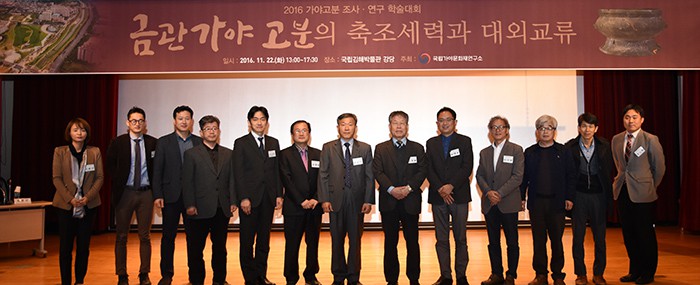A recent symposium has focused on ancient tombs and trading patterns of Geumgwan Gaya (금관 가야, 金官 加耶), delving into the lives, burial traditions and exchanges that took place in one of Korea’s many ancient kingdoms.
Geumgwan Gaya, also known as the Garakguk kingdom (가락국), existed and flourished around Gimhae in Gyeongsangnam-do Province from around 43 A.D. to 532 A.D.
On Nov. 22, the Gaya National Research Institute of Cultural Heritage, part of the Cultural Heritage Administration (CHA), hosted the symposium at the Gimhae National Museum in Gimhae, the ancient capital of Geumgwan Gaya. The theme was “Geumgwan Gaya’s Ancient Tombs & Overseas Trade,” and historians and researchers looked at burial traditions, foreign exchanges and living conditions of those times.

Participants in a symposium about ancient Geumgwan Gaya tombs and ancient trade patterns across the region pose for a group photo at the Gimhae National Museum in Gimhae, Gyeongsangnam-do Province, on Nov. 22.
The conference examined the building techniques and social classes found in ancient grave sites from Geumgwan Gaya. The tombs include a mokgwakmyo (목곽묘, 木槨墓), a burial method in which a wooden coffin was placed in a hole in the ground and then another larger coffin was placed on top of it. They also looked at stone-lined rectangular tombs, known as a seokgwakmyo (석곽묘, 石槨墓).
Participants looked closer at a series of relics excavated from such tombs, too, agreeing that the historical remains all point to the existence of trade and exchange between Geumgwan Gaya and ancient kingdoms in what are today China and Japan.
Finally, the researchers examined tools discovered in the graves to see how ancient people survived. They also introduced new aspects of Geumgwan Gaya rarely discussed before, like earthen buildings and castles, known as tulou (토루, 土壘).

Chikara Inoue (井上主税) from the Archaeological Institute of Kashihara in Japan gives a presentation on the traces that prove the existence of trade between Geumgwan Gaya and ancient kingdoms in what is today Japan, at the Gimhae National Museum in Gimhae, Gyeongsangnam-do Province, on Nov. 22.
“This symposium went beyond mere discussion about research into excavated relics. It exposed the burial and funereal customs that Geumgwan Gaya people had by analyzing the structures and building techniques of ancient tombs,” said an official from the Gaya National Research Institute of Cultural Heritage.
“It was also a rare chance to understand that a variety of non-Gaya relics found in the ancient tombs revealed how considerable the stature of the kingdom was across ancient East Asia.”
By Sohn JiAe
Korea.net Staff Writer
Photos: Gaya National Research Institute of Cultural Heritage






![[102nd March First Independence Movement Day] American journalist’s Seoul home to be opened to public](https://gangnam.com/file/2021/03/usr_1614255694426-218x150.jpg)
















